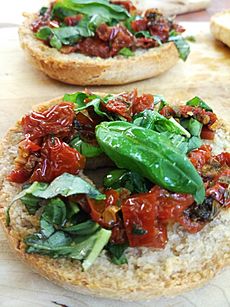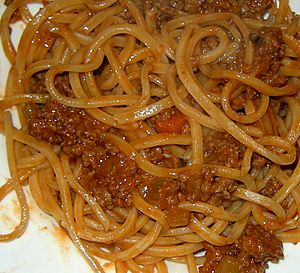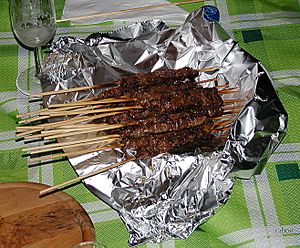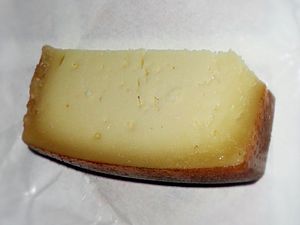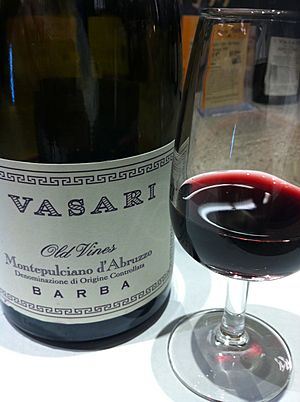Cuisine of Abruzzo facts for kids
The traditional food of Abruzzo, a region in Italy, is a mix of different styles. It includes dishes from mountain areas, coastal towns, and places where people raise sheep. Important foods in Abruzzo are bread, pasta, meat, cheese, and wine. For many years, Abruzzo was quite isolated. This helped its food traditions stay unique and different from nearby regions. In 2013, many tourists from other countries really enjoyed the local food.
Contents
Special Ingredients from Abruzzo
Abruzzo food is famous for using these special ingredients:
- Saffron of l'Aquila: This valuable spice is grown mainly in Navelli and L'Aquila.
- Olive oil: The olive oil from the Teramo hills (called Colline Teramane) is known for its high quality. It even has a special European Union quality mark (DOP).
- Liquorice of Atri: This sweet root is mostly grown in Abruzzo and Calabria.
- Lamb and mutton: These meats are very popular, especially in the mountains. Sheep's milk is used to make important Abruzzese cheeses like ricotta. Even sheep intestines are used for sausage casings or to make stuffed meat rolls. Sometimes, mountain goat meat is also eaten.
- Truffles and mushrooms: Wild mushrooms and truffles are often found in the forests and hills.
- Garlic: Especially red garlic, is a common ingredient.
- Rosemary: This herb adds great flavor to many dishes.
- Hot chili peppers: Known as diavolilli or diavoletti, these peppers add a spicy kick to many Abruzzese meals.
- Vegetables: Important vegetables include lentils, grasspeas, and other legumes. Also, artichokes, eggplants, and cauliflower are used.
Delicious Dishes
Tasty Starters
In Abruzzo, starters (called antipasti) get your meal off to a great start:
- Bruschetta: This is toasted bread rubbed with salt and oil. It can also have toppings like sausage, tomato, or zucchini with mozzarella cheese.
- Antipasto di fegatini: A starter from Teramo made with chicken livers, onion, peppers, and various seasonings.
- Mussels of Vasto: Mussels are stuffed with breadcrumbs, garlic, parsley, olive oil, lemon juice, and tomato sauce.
- Mussels with saffron: Steamed mussels prepared with parsley, onion, bay leaf, white wine, olive oil, and a special saffron sauce.
- Baccalà or salt cod: Cod fish cooked in a pan with potatoes, tomatoes, oil, garlic, parsley, onion, red pepper, salt, and black olives.
- Sauce all'aquilana: A rich sauce made with beef marrow, saffron, eggs, cream, and butter.
Amazing Pasta Dishes
One of the most popular pasta dishes in Abruzzo is maccheroni alla chitarra.
- This pasta is made by pressing dough through a special tool called a chitarra (which means "guitar"). It makes long, thin noodles, similar to spaghetti.
- It's usually served with a tomato-based sauce. This sauce often has peppers, pork, goose, or lamb.
- A common side dish is sagne e fagioli. This is a bean-and-noodle soup flavored with tomatoes, garlic, oil, and spicy peperoncini.
- Other popular pasta dishes include gnocchi carrati, which are flavored with bacon and pecorino cheese.
- Pastuccia is another dish, made with polenta (a cornmeal dish) mixed with sausage, eggs, and cheese.
Hearty Main Courses
Abruzzo is known for its delicious lamb and mutton dishes:
- Arrosticini: These are small pieces of lamb or mutton cooked on skewers. They are very popular!
- Pecora al cotturo: Lamb or mutton stuffed with mountain herbs and cooked slowly in a copper pot.
- Lamb cooked whole: Sometimes, a whole lamb is cooked in a traditional bread oven.
- Agnello cacio e ovo: A lamb-based fricassee (a stew with a creamy sauce).
Other main courses include:
- Mazzerella: Lamb intestines stuffed with lamb meat, garlic, marjoram, lettuce, and spices.
- Le virtù: A special soup from Teramo. It has many legumes, vegetables, and pork. People usually eat it in the spring for celebrations.
- Timballo abruzzese: This dish is like lasagna. It uses thin pasta sheets called scrippelle layered with meat, vegetables, and rice. It's often served for Christmas and Easter.
- Porchetta abruzzese: A moist, boneless pork roast. It's slow-roasted with rosemary, garlic, and pepper. This dish was brought to the northeastern United States by Abruzzese immigrants.
- Sagne e fagioli: Handmade pasta with beans and a tasty tomato sauce.
Fresh Seafood Dishes
Seafood is very important in Abruzzo, especially near the coast:
- Brodetti: A fish broth or stew from coastal towns like Vasto, Giulianova, and Pescara. It's cooked in an earthenware pot and flavored with tomatoes, herbs, and peperoncino.
- Escabeche: Marinated fish from Vasto. This is one of the few dishes in Abruzzo that uses saffron. The fish (often skate) is fried, then soaked in a vinegar-based marinade. This marinade can keep the fish fresh for a long time.
- Stockfish (Baccalà): Cod fish cooked in a pan with potatoes, tomatoes, oil, garlic, parsley, onion, red pepper, salt, and black olives.
- Marinated anchovies: Anchovies seasoned with garlic, parsley, oregano, lemon, oil, salt, and pepper.
- Mussels with saffron: Classic cooked mussels prepared with parsley, onion, bay leaf, white wine, olive oil, and seasoned with saffron sauce.
- Marinara appetizer: A mixed fish appetizer with squid, clams, and scampi. It's seasoned with a sauce made from anchovies, tuna, capers, vinegar, garlic, and parsley.
- Raw squid: A dish typical of Pescara. Baby squid are boiled in vinegar, then seasoned with chopped garlic sauce, extra virgin olive oil, lemon juice, salt, and hot pepper.
- Vastese-style mussels: Mussels stuffed with a mix of breadcrumbs, minced garlic, parsley, oil, lemon juice, and a little tomato sauce.
- Appetizer alla giuliese: Mixed fish with minced garlic, parsley, lemon juice, oil, salt, and a green sauce made with tuna, anchovies, capers, green peppers, oil, and vinegar.
- Crostini alla chietina: Homemade triangular slices of bread dipped in beaten egg and fried. They are often topped with anchovies, capers, and butter.
- Pasta with Scampi: A typical dish from the coast between Pescara and Vasto. It uses Adriatic scampi, tomato, garlic, and parsley. A light sauce is made to go with Spaghetti alla Chitarra or Rintrocilo pasta.
- Pasta alla chitarra con i Pelosi: Another seafood dish from Abruzzo, made with large hairy crabs found on the cliffs. These crabs are now very rare, so catching them is mostly not allowed. However, you might still find this dish in some local restaurants.
Breads and Pizzas
Abruzzo has many traditional breads and rustic pizzas:
- Pane di mais: This is cornbread, often made into loaves. A special Easter version adds boiled potatoes, olive oil, eggs, and milk.
- Bread of Senator Cappelli: This bread, mainly from the province of Chieti, has become popular again.
- Bread ear: Named because it looks like an ear.
- Scrippelle: A rustic pancake-like dish from Teramo. It's similar to a French-style crêpe. It can be served in broth (called mbusse) or as part of a soufflé with ragù sauce, stuffed with chicken liver, meatballs, hard-boiled eggs, and cheese.
Rustic pizzas are also common:
- Easter Pizza (Pizza di Pasqua): A rustic pizza with cheese and pepper from the Teramo area.
- Pizza fritta: Pizza that is shallow-fried.
- Fiadoni: From Chieti, this is a dough made with eggs and cheese, baked in a thin pastry shell.
Salumi (Cured Meats)
Salumi is an Italian word for cured meat products, mostly made from pork.
- Teramo cuisine is known for spreadable sausage flavored with nutmeg and liver sausage with garlic and spices.
- Ventricina: From the Vasto area, this is made with large pieces of fat and lean pork. It's pressed and seasoned with sweet peppers and fennel, then put into a dried pig stomach casing.
- Mortadella di Campotosto: Very well-known in Abruzzo. This is an oval, dark-red mortadella with a white column of fat in the middle. It's often sold in pairs, tied together. It's made from shoulder and loin meat, prosciutto trimmings, and fat. It's mostly lean meat.
Delicious Cheeses
Abruzzo produces many types of cheese:
- White cow cheese: A soft cheese made from cow's milk.
- Caciocavallo abruzzese: A soft, slightly stretchy cheese made from raw cow's milk.
- Caciofiore Aquilano: Made from raw sheep's milk, rennet, artichokes, and saffron. The saffron gives it a special yellow color.
- Caciotta vaccination frentana: A semi-hard cheese made from raw cow's milk.
- Canestrato of Castel del Monte: A hard cheese made from raw sheep's milk.
- Caprino abruzzese: Made from raw goat milk, sometimes mixed with sheep's milk.
- Cheese and curd stazzo: Cheeses and other products made from processing raw milk from sheep, cattle, and goats.
- Junket vaccination or Abruzzo sprisciocca: A soft, fresh cheese made from raw cow's milk.
- Pecorino d'Abruzzo: One of Abruzzo's most famous cheeses. It's a mild, semi-hard (or hard) cheese with small holes, made from raw sheep's milk.
- Pecorino di Atri: A firm, semi-cooked cheese made from sheep's milk.
- Pecorino di Farindola: A unique cheese made from sheep's milk using pork rennet.
- Ricotta: A soft cheese made from the leftover parts of sheep's milk after cheese-making.
- Scamorza d'Abruzzo: A stretched curd cheese made from cow's milk.
The towns of Atri and Rivisondoli are especially known for their cheeses. Mozzarella in Abruzzo is often made from ewe's (sheep's) milk.
Sweet Desserts and Treats
Abruzzo is famous for its delicious sweets:
- Dragée (confetti): Sugar-coated almonds from Sulmona.
- Torrone Nurzia: A chocolate nougat from L'Aquila.
- Parrozzo: A cake-like treat made from crushed almonds and covered in chocolate.
- Pizzelle (ferratelle): A thin, crispy waffle cookie, often flavored with anise.
- Croccante: A type of nougat made from almonds and caramelized sugar, often with lemon flavor.
- Calgionetti, cagionetti, caggiunitti, caviciunette: Christmas fritters. They are sometimes filled with chestnuts or chickpeas and flavored with chocolate or cocoa.
- Bocconotti: Stuffed sweets often served for Christmas.
- Zeppole di San Giuseppe: Fried or baked pastries made for Saint Joseph's Day.
- Sise delle monache [it]: A special cake from Guardiagrele in the Chieti province. It has two layers of sponge cake filled with custard.
Fresh Fruits
Abruzzo grows several important fruits:
- Agrumi della costa dei trabocchi: Citrus fruits (especially oranges) from the coast. They are used for jam and limoncello (a lemon liqueur).
- Castagna roscetta della Valle Roveto and Marrone di Valle Castellana: These are special types of chestnut.
- Ciliege di Raiano e di Giuliano Teatino: A local type of cherry.
- Mandorle di Navelli: Almonds from the town of Navelli.
- Mela della Valle Giovenco: Apples from the region.
- Uva di Tollo e Ortona: Table grapes, also used for making jam.
Regional Beverages
Abruzzo is known for its regional drinks:
- Montepulciano d'Abruzzo: A popular red wine.
- Cerasuolo d'Abruzzo: Another type of wine from the region.
- Trebbiano d'Abruzzo: The region's main white wine. In 2012, it was even ranked among the top Italian wines. Other wines include Montonico, Pecorino, Passerina, and Controguerra.
Local liqueurs (sweet alcoholic drinks) include:
- Genziana liqueur: Made from gentian root.
- Centerba: An aromatic liqueur made from infused herbs.
- Aurum: A brandy-based liqueur from Pescara infused with oranges.
- Ratafià: A liqueur made from black cherries and wine, often Montepulciano d'Abruzzo.
- Amaro Abruzzese: Made from herbs, roots, and fresh citrus fruits.
The region also has many special wines with a protected geographical indication (IGT). These include Alto Tirino, Colli Aprutini, Colli del Sangro, Colline Frentane, Colline Pescaresi, Colline Teatine, Del Vastese (or Histonium), Terre di Chieti, and Valle Peligna.
|
See also
 In Spanish: Gastronomía de Abruzos para niños
In Spanish: Gastronomía de Abruzos para niños


